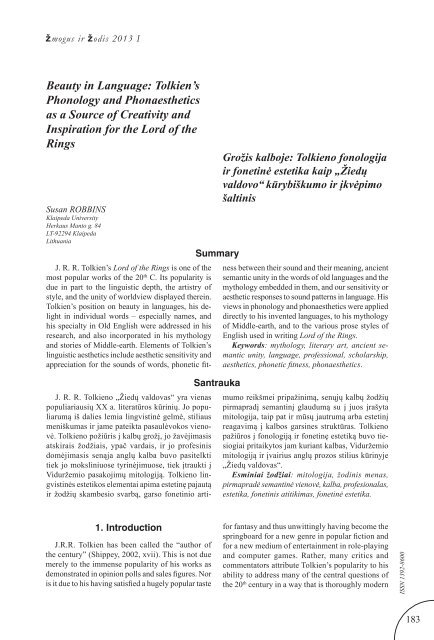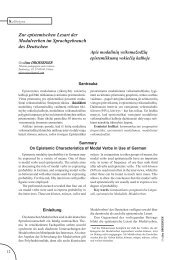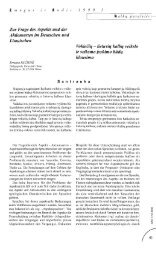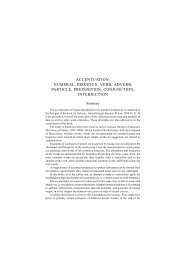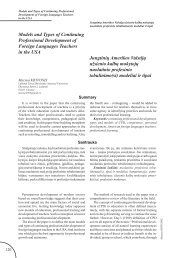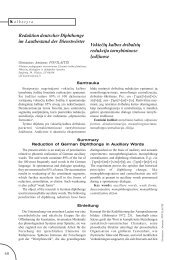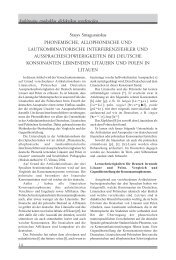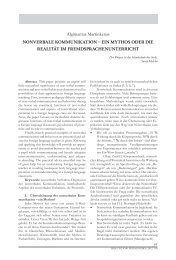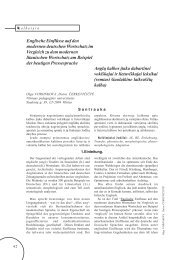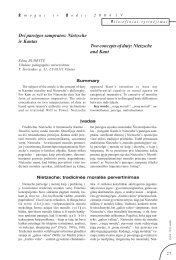Beauty in Language: Tolkien's Phonology and ... - Biblioteka
Beauty in Language: Tolkien's Phonology and ... - Biblioteka
Beauty in Language: Tolkien's Phonology and ... - Biblioteka
You also want an ePaper? Increase the reach of your titles
YUMPU automatically turns print PDFs into web optimized ePapers that Google loves.
žmogus ir žodis 2013 I<br />
<strong>Beauty</strong> <strong>in</strong> <strong>Language</strong>: Tolkien’s<br />
<strong>Phonology</strong> <strong>and</strong> Phonaesthetics<br />
as a Source of Creativity <strong>and</strong><br />
Inspiration for the Lord of the<br />
R<strong>in</strong>gs<br />
Susan ROBBINS<br />
Klaipeda University<br />
Herkaus Manto g. 84<br />
LT-92294 Klaipeda<br />
Lithuania<br />
Summary<br />
Santrauka<br />
Grožis kalboje: Tolkieno fonologija<br />
ir fonet<strong>in</strong>ė estetika kaip „Žiedų<br />
valdovo“ kūrybiškumo ir įkvėpimo<br />
šalt<strong>in</strong>is<br />
J. R. R. Tolkien’s Lord of the R<strong>in</strong>gs is one of the<br />
most popular works of the 20 th C. Its popularity is<br />
due <strong>in</strong> part to the l<strong>in</strong>guistic depth, the artistry of<br />
style, <strong>and</strong> the unity of worldview displayed there<strong>in</strong>.<br />
Tolkien’s position on beauty <strong>in</strong> languages, his delight<br />
<strong>in</strong> <strong>in</strong>dividual words – especially names, <strong>and</strong><br />
his specialty <strong>in</strong> Old English were addressed <strong>in</strong> his<br />
research, <strong>and</strong> also <strong>in</strong>corporated <strong>in</strong> his mythology<br />
<strong>and</strong> stories of Middle-earth. Elements of Tolkien’s<br />
l<strong>in</strong>guistic aesthetics <strong>in</strong>clude aesthetic sensitivity <strong>and</strong><br />
appreciation for the sounds of words, phonetic fitness<br />
between their sound <strong>and</strong> their mean<strong>in</strong>g, ancient<br />
semantic unity <strong>in</strong> the words of old languages <strong>and</strong> the<br />
mythology embedded <strong>in</strong> them, <strong>and</strong> our sensitivity or<br />
aesthetic responses to sound patterns <strong>in</strong> language. His<br />
views <strong>in</strong> phonology <strong>and</strong> phonaesthetics were applied<br />
directly to his <strong>in</strong>vented languages, to his mythology<br />
of Middle-earth, <strong>and</strong> to the various prose styles of<br />
English used <strong>in</strong> writ<strong>in</strong>g Lord of the R<strong>in</strong>gs.<br />
Keywords: mythology, literary art, ancient semantic<br />
unity, language, professional, scholarship,<br />
aesthetics, phonetic fitness, phonaesthetics.<br />
J. R. R. Tolkieno „Žiedų valdovas“ yra vienas<br />
populiariausių XX a. literatūros kūr<strong>in</strong>ių. Jo populiarumą<br />
iš dalies lemia l<strong>in</strong>gvist<strong>in</strong>ė gelmė, stiliaus<br />
meniškumas ir jame pateikta pasaulėvokos vienovė.<br />
Tolkieno požiūris į kalbų grožį, jo žavėjimasis<br />
atskirais žodžiais, ypač vardais, ir jo profes<strong>in</strong>is<br />
domėjimasis senąja anglų kalba buvo pasitelkti<br />
tiek jo moksl<strong>in</strong>iuose tyr<strong>in</strong>ėjimuose, tiek įtraukti į<br />
Viduržemio pasakojimų mitologiją. Tolkieno l<strong>in</strong>gvist<strong>in</strong>ės<br />
estetikos elementai apima estet<strong>in</strong>ę pajautą<br />
ir žodžių skambesio svarbą, garso fonet<strong>in</strong>io artimumo<br />
reikšmei pripaž<strong>in</strong>imą, senųjų kalbų žodžių<br />
pirmapradį semant<strong>in</strong>į glaudumą su į juos įrašyta<br />
mitologija, taip pat ir mūsų jautrumą arba estet<strong>in</strong>į<br />
reagavimą į kalbos gars<strong>in</strong>es struktūras. Tolkieno<br />
pažiūros į fonologiją ir fonet<strong>in</strong>ę estetiką buvo tiesiogiai<br />
pritaikytos jam kuriant kalbas, Viduržemio<br />
mitologiją ir įvairius anglų prozos stilius kūr<strong>in</strong>yje<br />
„Žiedų valdovas“.<br />
Esm<strong>in</strong>iai žodžiai: mitologija, žod<strong>in</strong>is menas,<br />
pirmapradė semant<strong>in</strong>ė vienovė, kalba, profesionalas,<br />
estetika, fonet<strong>in</strong>is atitikimas, fonet<strong>in</strong>ė estetika.<br />
1. Introduction<br />
J.R.R. Tolkien has been called the “author of<br />
the century” (Shippey, 2002, xvii). This is not due<br />
merely to the immense popularity of his works as<br />
demonstrated <strong>in</strong> op<strong>in</strong>ion polls <strong>and</strong> sales figures. Nor<br />
is it due to his hav<strong>in</strong>g satisfied a hugely popular taste<br />
for fantasy <strong>and</strong> thus unwitt<strong>in</strong>gly hav<strong>in</strong>g become the<br />
spr<strong>in</strong>gboard for a new genre <strong>in</strong> popular fiction <strong>and</strong><br />
for a new medium of enterta<strong>in</strong>ment <strong>in</strong> role-play<strong>in</strong>g<br />
<strong>and</strong> computer games. Rather, many critics <strong>and</strong><br />
commentators attribute Tolkien’s popularity to his<br />
ability to address many of the central questions of<br />
the 20 th century <strong>in</strong> a way that is thoroughly modern<br />
ISSN 1392-8600<br />
183
<strong>Beauty</strong> <strong>in</strong> <strong>Language</strong>: Tolkien’s <strong>Phonology</strong> <strong>and</strong><br />
Phonaesthetics as a Source of Creativity <strong>and</strong><br />
Inspiration for the Lord of the R<strong>in</strong>gs<br />
Grožis kalboje: Tolkieno fonologija ir fonet<strong>in</strong>ė estetika<br />
kaip „Žiedų valdovo“ kūrybiškumo ir įkvėpimo šalt<strong>in</strong>is<br />
<strong>in</strong> idea <strong>and</strong> at the same time mythical <strong>and</strong> timeless<br />
<strong>in</strong> style.<br />
Tolkien was born <strong>in</strong> 1892, <strong>and</strong> started learn<strong>in</strong>g<br />
foreign languages as early as age 6, learn<strong>in</strong>g Lat<strong>in</strong>,<br />
French, <strong>and</strong> German from his mother, who died<br />
when he was 12 years old. He studied Anglo-Saxon<br />
<strong>and</strong> Gothic as a schoolboy, <strong>and</strong> first encountered<br />
Welsh <strong>and</strong> F<strong>in</strong>nish as an undergraduate at Oxford<br />
University. After the war he worked for two<br />
years on the Oxford English Dictionary, <strong>and</strong> then<br />
became a professor of Anglo-Saxon, teach<strong>in</strong>g at<br />
Oxford University for over 30 years. Two other<br />
relevant facts that give a significant orientation to<br />
underst<strong>and</strong><strong>in</strong>g Tolkien are that he was a Roman<br />
Catholic Christian, which shaped the concepts <strong>and</strong><br />
pr<strong>in</strong>ciples operant <strong>in</strong> his mythology <strong>and</strong> <strong>in</strong> Lord<br />
of the R<strong>in</strong>gs (hereafter referred to as LOTR); <strong>and</strong><br />
that he fought <strong>in</strong> WWI <strong>in</strong> the Battle of the Somme.<br />
Thus he was familiar with the horrors of modern<br />
<strong>in</strong>dustrialized warfare, with genocide, addiction,<br />
environmental destruction, genetic eng<strong>in</strong>eer<strong>in</strong>g,<br />
the corruption follow<strong>in</strong>g lust for power, <strong>and</strong> they<br />
all appear <strong>in</strong> LOTR.<br />
As a professional philologist, Tolkien addressed<br />
his scholarly research <strong>in</strong>to Old Norse, Old English,<br />
Gothic, <strong>and</strong> other old European languages <strong>and</strong> the<br />
literature <strong>in</strong> these old languages. (His works will be<br />
cited by abbreviated title, follow<strong>in</strong>g the tradition <strong>in</strong><br />
Tolkienian scholarship; other sources will be given<br />
st<strong>and</strong>ard citations.) His private amusement was to<br />
<strong>in</strong>vent languages, along with speakers for them, <strong>and</strong><br />
histories for the speakers, which became his mythology<br />
of Middle-earth. The two enterprises were<br />
<strong>in</strong>timately entangled with each other, but Tolkien’s<br />
philology preceded his mythology. The mythology<br />
had scholarly <strong>and</strong> philological roots. Tolkien worked<br />
on his private languages <strong>and</strong> legends for over 60<br />
years, <strong>and</strong> The Hobbit <strong>and</strong> LOTR are someth<strong>in</strong>g like<br />
isl<strong>and</strong>s <strong>in</strong> a vast sea of his legendary output. This<br />
output was posthumously edited <strong>and</strong> published as<br />
The History of Middle-earth <strong>in</strong> twelve volumes by<br />
his son, Christopher Tolkien.<br />
Tolkien himself said that the object he aimed for<br />
with LOTR was to produce a work to be enjoyed as<br />
such: to be read with literary pleasure. So that any<br />
reader whom the author has (to his great satisfaction)<br />
succeeded <strong>in</strong> ‘pleas<strong>in</strong>g’ (excit<strong>in</strong>g, engross<strong>in</strong>g, mov<strong>in</strong>g,<br />
etc.), should, if he wishes others to be similarly<br />
pleased, endeavor to <strong>in</strong>duce them to read it with<br />
literary pleasure (Letters, 1981, 414).<br />
Literary pleasure was, for Tolkien, tied up with<br />
his professional <strong>in</strong>terests as a philologist. In fact<br />
Tolkien consistently made no dist<strong>in</strong>ction between his<br />
so-called hobby <strong>and</strong> his professional work (Shippey,<br />
2002, xvi).<br />
Accord<strong>in</strong>gly, my aim here is to show that the<br />
l<strong>in</strong>guistic beauty of LOTR is not accidental, but is<br />
a demonstration of Tolkien’s professional views of<br />
language <strong>and</strong> art, <strong>and</strong> of his philological skill. First,<br />
philology is the ma<strong>in</strong> source of Tolkien’s creativity<br />
<strong>and</strong> means of mythical <strong>in</strong>vention. Second, Tolkien’s<br />
tastes <strong>in</strong> phonology <strong>and</strong> phonaesthetics as applied<br />
<strong>in</strong> LOTR give the flavour <strong>and</strong> appeal of the <strong>in</strong>vented<br />
‘elvish’ languages, <strong>and</strong> all the names <strong>and</strong> other applications<br />
of these languages to the story. Third,<br />
Tolkien takes his own aesthetic taste with regard to<br />
language, <strong>in</strong>serts it <strong>in</strong>to the story <strong>and</strong> gives it to some<br />
of the characters, especially elves, <strong>and</strong> creates a correspond<strong>in</strong>g<br />
prose style <strong>in</strong> English such that readers<br />
of LOTR can experience this beauty for themselves.<br />
2. Philology <strong>and</strong> Literary Artistic<br />
Invention<br />
I beg<strong>in</strong> by present<strong>in</strong>g Tolkien’s aesthetic sensitivities,<br />
his philological expertise, <strong>and</strong> the exercise of<br />
these skills for LOTR. There are three po<strong>in</strong>ts to be<br />
made <strong>in</strong> this section. The first is to note is that Tolkien<br />
thought all languages had an aesthetic flavour <strong>and</strong><br />
could be appreciated <strong>in</strong> their own right apart from any<br />
utilitarian purpose they might be put to. They can be<br />
“tasted” like poetry or music <strong>and</strong> some are beautiful<br />
<strong>and</strong> give great aesthetic pleasure. Be<strong>in</strong>g a philologist,<br />
gett<strong>in</strong>g a large part of any aesthetic pleasure that I am<br />
capable of from the form of words (<strong>and</strong> especially<br />
from the fresh association of word-form with wordsense),<br />
I have always best enjoyed th<strong>in</strong>gs <strong>in</strong> a foreign<br />
language (English <strong>and</strong> Welsh, 191).<br />
It is <strong>in</strong> encounter<strong>in</strong>g foreign languages that this<br />
aesthetic pleasure is best felt. Tolkien remarks that<br />
both English <strong>and</strong> Lat<strong>in</strong> (as his first-learned foreign<br />
language) “seemed so normal that pleasure or distaste<br />
were equally <strong>in</strong>applicable” (English <strong>and</strong> Welsh,<br />
191). Greek, Gothic, Welsh, <strong>and</strong> F<strong>in</strong>nish all had this<br />
aesthetic effect on him. In his essays <strong>and</strong> letters he<br />
comments that “Gothic was the first to take me by<br />
storm, to move my heart” (English <strong>and</strong> Welsh, p.<br />
191). Elsewhere he says, “There is a purely artistic<br />
pleasure, keen <strong>and</strong> of a high order, <strong>in</strong> study<strong>in</strong>g a<br />
Gothic dictionary from this po<strong>in</strong>t of view” (A Secret<br />
Vice, 207). Of his first encounter with F<strong>in</strong>nish he<br />
wrote <strong>in</strong> a letter to W.H. Auden, Most important,<br />
perhaps, after Gothic, was the discovery <strong>in</strong> Exeter<br />
College library of a F<strong>in</strong>nish Grammar. It was<br />
like discover<strong>in</strong>g a complete w<strong>in</strong>e-cellar filled with<br />
bottles of an amaz<strong>in</strong>g w<strong>in</strong>e of a k<strong>in</strong>d <strong>and</strong> flavour<br />
Susan ROBBINS<br />
184
žmogus ir žodis 2013 I<br />
never tasted before. It quite <strong>in</strong>toxicated me <br />
(Letters, 214).<br />
Tolkien later writes that Welsh “was bound to<br />
w<strong>in</strong> <strong>in</strong> the end, though long baulked by sheer lack<br />
of opportunity. . . . it pierced my l<strong>in</strong>guistic heart. . . .<br />
Welsh is of this soil, this isl<strong>and</strong>, the senior language of<br />
the men of Brita<strong>in</strong>; <strong>and</strong> Welsh is beautiful” (English<br />
<strong>and</strong> Welsh, 192, 189). This aesthetic pleasure Tolkien<br />
felt read<strong>in</strong>g grammars <strong>and</strong> dictionaries encouraged<br />
him to th<strong>in</strong>k that the <strong>in</strong>vention or construction of<br />
purely made-up languages could be a valid art-form,<br />
as opposed to merely a game children amuse themselves<br />
with. He had been <strong>in</strong>vent<strong>in</strong>g languages s<strong>in</strong>ce<br />
childhood, but after encounter<strong>in</strong>g Gothic, Welsh,<br />
<strong>and</strong> F<strong>in</strong>nish <strong>in</strong> college, he took the development<br />
<strong>and</strong> construction of them much more seriously. Two<br />
of them, one modelled on F<strong>in</strong>nish <strong>and</strong> the other on<br />
Welsh <strong>in</strong> phonetic pattern <strong>and</strong> grammatical structure,<br />
became the elvish languages that appeared <strong>in</strong> LOTR.<br />
The second po<strong>in</strong>t concerns Tolkien’s views of the<br />
relation between philology <strong>and</strong> mythology. All languages<br />
have a history. <strong>Language</strong>s grow <strong>and</strong> develop;<br />
they also wear down. Words wear down, so does<br />
the structure of the languages. They beg<strong>in</strong> by be<strong>in</strong>g<br />
highly <strong>in</strong>flected: Lithuanian <strong>and</strong> Lat<strong>in</strong> have seven<br />
cases. By contrast English has been worn down to<br />
the po<strong>in</strong>t of no case end<strong>in</strong>gs at all. <strong>Language</strong>s also<br />
borrow from one another, <strong>and</strong> words can be traced<br />
from language to language, follow<strong>in</strong>g the movement<br />
of the th<strong>in</strong>gs or ideas they represent from place to<br />
place (Lobdell, 1975, 30–31). The very earliest uses<br />
we have of language are <strong>in</strong> the myths <strong>and</strong> poems<br />
told <strong>in</strong> those languages. The early literature gives us<br />
a feel for the history of the languages, as well as for<br />
the mythical consciousness of the cultures that spoke<br />
<strong>and</strong> wrote <strong>in</strong> these languages. Tolkien replicated this<br />
feel <strong>in</strong> his legends of Middle-earth.<br />
It is especially <strong>in</strong> names <strong>and</strong> place-names that one<br />
can see the past alive <strong>in</strong> the present. “Out of these<br />
languages are made nearly all the names that appear<br />
<strong>in</strong> my legends. This gives a certa<strong>in</strong> character (a cohesion,<br />
a consistency of l<strong>in</strong>guistic style, <strong>and</strong> an illusion<br />
of historicity) to the nomenclature” (Letters, 143).<br />
Every real language has a history; so constructed<br />
languages must have a hypothetical or feigned history<br />
also, if the <strong>in</strong>vention is not to be merely a code (A<br />
Secret Vice, 210). It is because an <strong>in</strong>vented language<br />
requires the illusion of historicity that Tolkien claims,<br />
“For perfect construction of an art language, it is<br />
necessary to construct at least <strong>in</strong> outl<strong>in</strong>e a mythology<br />
concomitant. The mak<strong>in</strong>g of language <strong>and</strong> mythology<br />
are related functions . . . a mythology is necessary<br />
to give your language an <strong>in</strong>dividual flavour”<br />
(A Secret Vice, 210). The history <strong>and</strong> mythology of<br />
Middle-earth is referred to <strong>in</strong> LOTR nearly a thous<strong>and</strong><br />
times. S<strong>in</strong>ce Tolkien worked nearly 60 years on the<br />
languages <strong>and</strong> their history, the worn down words,<br />
the loan words, the names <strong>and</strong> place-names together<br />
give Middle-earth the consistency <strong>and</strong> feel of reality,<br />
foreign <strong>and</strong> familiar at the same time.<br />
The third po<strong>in</strong>t deals with Tolkien’s demonstration<br />
of academic philology <strong>in</strong> the use of Anglo-Saxon,<br />
Old Norse, Old High German <strong>and</strong> other old northern<br />
European languages, that gives a feel of familiar<br />
antiquity to many of the peoples <strong>and</strong> creatures of<br />
Middle-earth. As Shippey has shown, Tolkien’s<br />
wargs, for example, were constructed from comb<strong>in</strong><strong>in</strong>g<br />
both the sounds <strong>and</strong> the ideas of the Old Norse<br />
word vargr which means both ‘wolf’ <strong>and</strong> ‘outlaw’,<br />
<strong>and</strong> the Old English words wearh, which means<br />
‘outcast’ or ‘outlaw’ but not ‘wolf’, <strong>and</strong> awyrgan,<br />
which means ‘to condemn’, or ‘to strangle’ or ‘to<br />
bite to death’ (Shippey, 2002, 30).<br />
Dwarves, too, are the product of Tolkien’s professional<br />
discipl<strong>in</strong>e. Modern English ‘dwarf’, modern<br />
German Zwerg, <strong>and</strong> Old Norse dvergr all could have<br />
a common source <strong>in</strong> *dvairgs, a word from which the<br />
later ones might have been derived. Tolkien <strong>in</strong>sisted<br />
that his publishers reta<strong>in</strong> the archaic plural ‘dwarves’<br />
even though the only correct plural <strong>in</strong> English at the<br />
time was ‘dwarfs’ (LOTR, 1136). Old words that end<br />
<strong>in</strong> –f that are still <strong>in</strong> use reta<strong>in</strong> the –ves end<strong>in</strong>g <strong>in</strong> the<br />
plural, such as wolf/wolves, leaf/leaves, calf/calves,<br />
<strong>and</strong> wife/wives. Modern words such as proof(s) do<br />
not. So to avoid the worn down, comical concept that<br />
we f<strong>in</strong>d <strong>in</strong> a tale such as Snow White <strong>and</strong> the Seven<br />
Dwarfs, Tolkien reta<strong>in</strong>ed the –ves plural to <strong>in</strong>dicate<br />
the dignity, strength <strong>and</strong> formidable character of the<br />
ancient concept (Shippey, 2002, xiv, xv, 15).<br />
Ents, orcs, hobbits, mathoms, smials, éored,<br />
woses, to mention only a few, are all actual Anglo-<br />
Saxon words or modernized from Anglo-Saxon<br />
words or Anglo-Saxon *words. Tolkien explicitly<br />
says these are not purely <strong>in</strong>vented words. They are<br />
applications of his philological scholarship; words<br />
that might have survived to our time but unfortunately<br />
did not (Guide, 175). His philological method<br />
was to look for gaps, errors, or contradictions <strong>in</strong><br />
Anglo-Saxon poetry, <strong>and</strong> pa<strong>in</strong>stak<strong>in</strong>gly reconstruct<br />
the words, the notions they refer to, <strong>and</strong> their place <strong>in</strong><br />
the ancient poems <strong>and</strong> <strong>in</strong> the imag<strong>in</strong>ative l<strong>and</strong>scape<br />
of the authors of those ancient poems. Sometimes<br />
Tolkien <strong>in</strong>vented a mythical reality for old words<br />
whose mean<strong>in</strong>g has been lost <strong>in</strong> the <strong>in</strong>terven<strong>in</strong>g years<br />
between the time when it was part of commonly<br />
known vocabulary <strong>and</strong> our time.<br />
ISSN 1392-8600<br />
185
<strong>Beauty</strong> <strong>in</strong> <strong>Language</strong>: Tolkien’s <strong>Phonology</strong> <strong>and</strong><br />
Phonaesthetics as a Source of Creativity <strong>and</strong><br />
Inspiration for the Lord of the R<strong>in</strong>gs<br />
Grožis kalboje: Tolkieno fonologija ir fonet<strong>in</strong>ė estetika<br />
kaip „Žiedų valdovo“ kūrybiškumo ir įkvėpimo šalt<strong>in</strong>is<br />
Perhaps the most important example of the past<br />
becom<strong>in</strong>g alive <strong>in</strong> the present is <strong>in</strong> the <strong>in</strong>vention of the<br />
R<strong>in</strong>gwraiths. ‘Wraith’ is a very old word, given two<br />
conflict<strong>in</strong>g mean<strong>in</strong>gs <strong>in</strong> the Oxford English Dictionary.<br />
One is the ghost of someone who has died; the<br />
other is an apparition of a liv<strong>in</strong>g person. The word<br />
has its orig<strong>in</strong> <strong>in</strong> the Anglo-Saxon word writhan, ‘to<br />
writhe’, which is also the root of our words ‘wrath’,<br />
<strong>and</strong> ‘wreath’ (Shippey, 2002, 123). Tolkien comb<strong>in</strong>es<br />
all these elements <strong>in</strong> his R<strong>in</strong>gwraiths. They are ghostly<br />
figures, rid<strong>in</strong>g real horses <strong>and</strong> wear<strong>in</strong>g real cloaks<br />
<strong>and</strong> armor, but completely <strong>in</strong>visible <strong>and</strong> as <strong>in</strong>tangible<br />
as smoke. They are embodiments of wrath, twisted<br />
by cruelty <strong>and</strong> malice, <strong>and</strong> their primary weapons<br />
are not their swords or maces but the terror, panic,<br />
<strong>and</strong> despair they <strong>in</strong>flict on their opponents. They<br />
were seduced by Sauron’s offer of power through the<br />
r<strong>in</strong>gs, <strong>and</strong> are so ensnared to his will that they have<br />
no <strong>in</strong>dividual sense of self left.<br />
These wraiths, Shippey po<strong>in</strong>t out, are completely<br />
plausible, because the examples of Ohlendorf, Eichmann,<br />
<strong>and</strong> the henchmen of Mao <strong>and</strong> Stal<strong>in</strong> give<br />
evidence that dedication to some cause or ideology,<br />
justify<strong>in</strong>g everyth<strong>in</strong>g they do, can destroy all moral<br />
consciousness <strong>and</strong> human fellow-feel<strong>in</strong>g <strong>in</strong> them.<br />
“The spectacle of the person ‘eaten up <strong>in</strong>side’ by<br />
devotion to some abstraction has been so familiar<br />
throughout the twentieth century as to make the idea<br />
of the wraith, <strong>and</strong> the wraith<strong>in</strong>g-process, horribly<br />
recognizable, <strong>in</strong> a way non-fantastic” (Shippey,<br />
2002, 125). The dreadful believability of the R<strong>in</strong>gwraiths,<br />
Shippey concludes, comes not from their<br />
medieval literary orig<strong>in</strong>s but from the twentieth century<br />
experience of evil displayed <strong>in</strong> them (Shippey,<br />
2002, 128).<br />
One more example comes from the Anglo-Saxon<br />
word smygels ‘a burrow’, <strong>and</strong> the Germanic word<br />
smugan ‘to creep’ (Gilliver et al, 2006, 191). From<br />
this Germanic verb came another Anglo-Saxon verb<br />
smeagan ‘to scrut<strong>in</strong>ize or <strong>in</strong>vestigate’. The name of<br />
Smeagol, the creature who came to be known as Gollum,<br />
was derived from this verb, <strong>and</strong> he had the habit<br />
of liv<strong>in</strong>g <strong>in</strong> dark caves <strong>and</strong> tunnels under the Misty<br />
Mounta<strong>in</strong>s. Tolkien began his earlier book The Hobbit,<br />
with the sentence “In a hole <strong>in</strong> the ground there<br />
lived a hobbit”, <strong>and</strong> tells us that hobbits called their<br />
holes ‘smials’. Tolkien philologically constructed the<br />
word ‘smials’ as an authentic modern English form<br />
of smygels, as if it had it survived to our time. The<br />
dragon Smaug also acquired his name from these<br />
roots: smaug is the past tense of the Germanic verb<br />
smugan ‘to creep through an open<strong>in</strong>g’, <strong>and</strong> Tolkien<br />
called it “a low philological jest” (Letters, 31).<br />
Shippey notes that because so many of Tolkien’s<br />
<strong>in</strong>ventions come from old, lost words of northern<br />
European languages, Tolkien didn’t th<strong>in</strong>k he was<br />
entirely <strong>in</strong>vent<strong>in</strong>g it all out of his own imag<strong>in</strong>ation.<br />
S<strong>in</strong>ce much of scientific etymology is based on the<br />
process of reconstruction, Tolkien was practic<strong>in</strong>g his<br />
specialty <strong>in</strong> much of his <strong>in</strong>vention (Shippey, 2002,<br />
xiv-xv). This is why Tolkien can say that LOTR is<br />
“fundamentally l<strong>in</strong>guistic <strong>in</strong> <strong>in</strong>spiration” <strong>and</strong> that it<br />
is “largely <strong>and</strong> essay <strong>in</strong> l<strong>in</strong>guistic aesthetic” (Letters,<br />
219–220).<br />
3. Phonetic Fitness <strong>and</strong> Ancient<br />
Semantic Depth <strong>in</strong> Tolkien’s<br />
Invented <strong>Language</strong>s<br />
There are two str<strong>and</strong>s of development <strong>in</strong> Tolkien’s<br />
views concern<strong>in</strong>g the close connection between<br />
words <strong>and</strong> th<strong>in</strong>gs. The first is the counter-tradition<br />
of philosophers such as Owen Barfield <strong>and</strong> Ernst<br />
Cassirer <strong>in</strong> the 1920s. It is called a counter-tradition<br />
because it counters the prevail<strong>in</strong>g views of Saussure<br />
<strong>and</strong> Chomsky, who held that the word or sound was<br />
purely arbitrary <strong>and</strong> completely unrelated to any<br />
referent connected with it. Wilhelm Humboldt, Sapir<br />
<strong>and</strong> Whorf, Otto Jesperson, Roman Jakobson <strong>and</strong> C.<br />
S. Peirce, who all researched sound symbolism, were<br />
part of this counter-tradition. More recently, other<br />
scientists such as Margaret Magnus <strong>and</strong> Vilayanur<br />
S. Ramach<strong>and</strong>ran have carried out detailed experiments<br />
to prove a clear relationship between sound<br />
<strong>and</strong> mean<strong>in</strong>g (Smith, 2011, 57).<br />
Tolkien was certa<strong>in</strong>ly familiar with the work of<br />
the early 20 th century theorists <strong>in</strong> sound symbolism,<br />
but was most <strong>in</strong>fluenced by Barfield. He commented<br />
that Barfield’s concept of ancient <strong>and</strong> orig<strong>in</strong>al semantic<br />
unity had modified his whole outlook on<br />
language (Flieger, 2012, 243–244). Among other<br />
th<strong>in</strong>gs that Tolkien <strong>and</strong> Barfield agreed upon was<br />
that language is at the root of human consciousness.<br />
He says, “<strong>Language</strong> – <strong>and</strong> more so as expression<br />
than as communication – is a natural product of our<br />
humanity” (English <strong>and</strong> Welsh, 190). Tolkien also<br />
thought that the natural environment of a people<br />
had a direct <strong>in</strong>fluence on the sounds of the ancient<br />
language spoken there.<br />
The second source for Tolkien’s views comes<br />
from his Christian faith. Although Middle-earth <strong>in</strong><br />
LOTR has no overt religious practice, no churches or<br />
temples, no ceremonial worship, <strong>and</strong> only traces of<br />
prayer <strong>in</strong> hymns <strong>and</strong> <strong>in</strong>vocations, it still has a clearly<br />
Christian sett<strong>in</strong>g <strong>and</strong> ethos. This religious element,<br />
Tolkien told a friend, “is absorbed <strong>in</strong>to the story <strong>and</strong><br />
Susan ROBBINS<br />
186
žmogus ir žodis 2013 I<br />
the symbolism” (Letters, 172). This is a l<strong>in</strong>e widely<br />
quoted <strong>and</strong> <strong>in</strong>terpreted by many commentators, but I<br />
underst<strong>and</strong> it to mean at the least that s<strong>in</strong>ce LOTR is<br />
also essentially l<strong>in</strong>guistic <strong>in</strong> <strong>in</strong>spiration, that Tolkien<br />
understood his philological <strong>in</strong>vestigations to shed<br />
light on the real world, <strong>and</strong> that the real world is <strong>in</strong><br />
fact the one created by God as told <strong>in</strong> Genesis <strong>and</strong><br />
the Prologue to the Gospel of John. Furthermore,<br />
Middle-earth is modeled on the real world <strong>in</strong> several<br />
ways, all of them l<strong>in</strong>ked to his professional views <strong>and</strong><br />
philological expertise.<br />
This consonance between Middle-earth <strong>and</strong> the<br />
real world is first of all demonstrated by the Christian<br />
doctr<strong>in</strong>e of creation by the spoken word. “And God<br />
said, “Let there be light,’ <strong>and</strong> there was light.” The<br />
world was not a pagan or even pre-Christian world <strong>in</strong><br />
B.C. year X. Christ, as the Word, the Logos of God,<br />
was <strong>in</strong>volved with the world from the beg<strong>in</strong>n<strong>in</strong>g. “In<br />
the beg<strong>in</strong>n<strong>in</strong>g was the Word . . . Without Him was<br />
not anyth<strong>in</strong>g made that was made” (John 1, 1–2).<br />
Christ is the spoken Word that brought the world <strong>in</strong>to<br />
be<strong>in</strong>g. Tolkien’s mythical story of the creation <strong>and</strong><br />
order<strong>in</strong>g of Middle-earth is given <strong>in</strong> the Silmarillion,<br />
the backstory to LOTR.<br />
But even more than the parallels of Tolkien’s<br />
creation myth with the Biblical account, is the significance<br />
of words <strong>and</strong> language <strong>and</strong> their <strong>in</strong>timate<br />
<strong>and</strong> essential unity with the th<strong>in</strong>gs they designate.<br />
He remarks on the “peculiar keenness of the delight<br />
scholars have <strong>in</strong> poetry or f<strong>in</strong>e prose <strong>in</strong> a foreign<br />
language” <strong>and</strong> says “it is the contemplation of the<br />
relation between sound <strong>and</strong> notion which is the ma<strong>in</strong><br />
source of pleasure” (A Secret Vice, 206). This relation<br />
is neither r<strong>and</strong>om nor arbitrary: through all the<br />
vowel mutations <strong>and</strong> consonant shifts <strong>in</strong> the history<br />
of language, the fitness between notion <strong>and</strong> oral<br />
symbol can be perceived, <strong>in</strong> some languages more<br />
<strong>and</strong> others less, <strong>and</strong> the connections between mother<br />
<strong>and</strong> daughter languages can be traced thereby.<br />
Nam<strong>in</strong>g, for Tolkien is not simply assign<strong>in</strong>g at<br />
r<strong>and</strong>om an arbitrary vocable to the th<strong>in</strong>g named. To<br />
name a th<strong>in</strong>g is to capture <strong>in</strong> articulated sound someth<strong>in</strong>g<br />
of its essence, some of its story. “Names both<br />
reflect <strong>and</strong> effect th<strong>in</strong>gs <strong>in</strong> Middle-earth. . . . names<br />
are th<strong>in</strong>gs, <strong>and</strong> names can make th<strong>in</strong>gs happen”<br />
(Walker, 2009, 130). “Real names tell you the story of<br />
the th<strong>in</strong>gs they belong to <strong>in</strong> my language,” Treebeard<br />
tells Merry <strong>and</strong> Pipp<strong>in</strong>, <strong>and</strong> he mildly objects to the<br />
word ‘hill’, say<strong>in</strong>g “it is a hasty word for a th<strong>in</strong>g<br />
that has stood here ever s<strong>in</strong>ce this part of the world<br />
was shaped” (LOTR, 465). Tolkien demonstrated the<br />
view expressed by Cassirer: “The notion that name<br />
<strong>and</strong> essence bear a necessary <strong>and</strong> <strong>in</strong>ternal relation to<br />
each other, that the name does not merely denote but<br />
actually is the essence of its object, that the potency<br />
of the real th<strong>in</strong>g is conta<strong>in</strong>ed <strong>in</strong> the name – that is one<br />
of the fundamental assumptions of the mythmak<strong>in</strong>g<br />
consciousness itself” (Cassirer, 1946, 3; Smith, 2012,<br />
59). The orig<strong>in</strong>al fitness between word <strong>and</strong> th<strong>in</strong>g is<br />
expressed <strong>in</strong> the repeated l<strong>in</strong>e “And God saw that it<br />
was good.” This is the orig<strong>in</strong>al source of the unity<br />
<strong>and</strong> <strong>in</strong>timacy of beauty, truth <strong>and</strong> goodness <strong>in</strong> the<br />
relation between word <strong>and</strong> th<strong>in</strong>g <strong>in</strong> Christianity as<br />
well as <strong>in</strong> Tolkien’s mythology. Another illustration<br />
is found <strong>in</strong> the story of Adam nam<strong>in</strong>g the animals.<br />
He is the prototype for all l<strong>in</strong>guistic <strong>in</strong>vention, the<br />
first literary artist.<br />
All ancient languages for Tolkien have this richness<br />
<strong>and</strong> depth because they are steeped <strong>in</strong> human<br />
experience <strong>and</strong> embedded <strong>in</strong> a mythology. “The potency<br />
of the word <strong>and</strong> the wonder of the th<strong>in</strong>g” (Stories,<br />
147) arise simultaneously <strong>and</strong> arise <strong>in</strong> a story.<br />
“The <strong>in</strong>carnate m<strong>in</strong>d, the tongue <strong>and</strong> the tale are <strong>in</strong><br />
our world coeval” (Stories, 148). He did not hold the<br />
reductionist view that language came first, <strong>and</strong> was<br />
followed by mythology like a disease. “Mythology<br />
is not a disease at all, though it may like all human<br />
th<strong>in</strong>gs become diseased. You might as well say that<br />
th<strong>in</strong>k<strong>in</strong>g is a disease of the m<strong>in</strong>d” (Stories, 121) In<br />
Barfield’s example, the Lat<strong>in</strong> word spiritus, Greek<br />
pneuma <strong>and</strong> Hebrew rauch all mean w<strong>in</strong>d-breathspirit<br />
simultaneously (Wood, 2003, 34; Birzer, 2002,<br />
30). To use such a word, for the ancients, would be<br />
to experience reality as nature, aliveness, <strong>and</strong> the<br />
div<strong>in</strong>e together, without any separation or division<br />
or shift<strong>in</strong>g from one to the other. Barfield argued that<br />
this ancient semantic depth revealed an ancient unified<br />
consciousness of the world, which has separated<br />
<strong>in</strong> modern times to separate consciousnesses, shown<br />
<strong>in</strong> our modern languages as separate mean<strong>in</strong>gs for<br />
the ancient word. A Lithuanian example would be<br />
a word such as ‘dangus’, which means, simultaneously<br />
<strong>and</strong> without division, both ‘heaven’ <strong>and</strong><br />
‘sky’. Owen Barfield, a philosopher <strong>and</strong> friend of<br />
Tolkien, argued that there is no dist<strong>in</strong>ction between<br />
spiritual reality (heaven) <strong>and</strong> physical reality (sky)<br />
for ancient speakers of such words. Accord<strong>in</strong>gly,<br />
poets <strong>and</strong> l<strong>in</strong>guists “f<strong>in</strong>d language grow<strong>in</strong>g more<br />
<strong>and</strong> more poetic as they trace it back <strong>in</strong>to the past”<br />
(Barfield, 1973, 83). Tolkien’s example is Thórr, the<br />
Norse god of thunder who resembles a red-bearded,<br />
hot-tempered farmer. Tolkien thought it was not<br />
worthwhile to ask which came first, nature-allegories<br />
about personalized thunder or the experience of an<br />
irascible bellow<strong>in</strong>g farmer <strong>in</strong> a rage. “It is more reasonable<br />
to suppose that the farmer popped up at the<br />
ISSN 1392-8600<br />
187
<strong>Beauty</strong> <strong>in</strong> <strong>Language</strong>: Tolkien’s <strong>Phonology</strong> <strong>and</strong><br />
Phonaesthetics as a Source of Creativity <strong>and</strong><br />
Inspiration for the Lord of the R<strong>in</strong>gs<br />
Grožis kalboje: Tolkieno fonologija ir fonet<strong>in</strong>ė estetika<br />
kaip „Žiedų valdovo“ kūrybiškumo ir įkvėpimo šalt<strong>in</strong>is<br />
very moment when Thunder got a voice <strong>and</strong> a face”<br />
(Stories, 124). In Tolkien’s own experience, the work<br />
on the <strong>in</strong>vented languages fueled the story, <strong>and</strong> the<br />
story cont<strong>in</strong>ually prompted a return to work on the<br />
languages. Tolkien found as he went along, that one<br />
cannot abstract language from a culture or a people<br />
(Letters, 216; Birzer, 2002, 32). So <strong>in</strong> <strong>in</strong>vent<strong>in</strong>g a<br />
language as an art form, it is necessary to <strong>in</strong>vent a<br />
mythology concomitant to give it someth<strong>in</strong>g of the<br />
semantic depth <strong>and</strong> richness a real language has.<br />
Otherwise it is noth<strong>in</strong>g but a code.<br />
Mythic experience gives way to express<strong>in</strong>g the<br />
association of words <strong>and</strong> th<strong>in</strong>gs. Upon reach<strong>in</strong>g Lothlórien<br />
“Frodo stood awhile still lost <strong>in</strong> wonder. . . .<br />
He saw no colour but those he knew, gold <strong>and</strong> white<br />
<strong>and</strong> blue <strong>and</strong> green, but they were fresh <strong>and</strong> poignant,<br />
as if he had at that moment first perceived them <strong>and</strong><br />
made for them names new <strong>and</strong> wonderful” (LOTR,<br />
350). For Tolkien a major response to the perception<br />
of beauty is philological, mak<strong>in</strong>g new <strong>and</strong> wonderful<br />
names that phonetically fit the th<strong>in</strong>gs named.<br />
This is high art, <strong>and</strong> Tolkien gives the artistic<br />
temperament <strong>and</strong> ability primarily to the elves.<br />
Treebeard tells Merry <strong>and</strong> Pipp<strong>in</strong> that “Elves made<br />
all the old words; they began it, . . . wak<strong>in</strong>g up the<br />
trees <strong>and</strong> teach<strong>in</strong>g them to speak, . . . They always<br />
wished to talk to everyth<strong>in</strong>g, the old Elves did. . .<br />
. It was the Elves that cured us of dumbness long<br />
ago, <strong>and</strong> that was a great gift” (LOTR, 468). Elvish<br />
names for natural th<strong>in</strong>gs <strong>and</strong> th<strong>in</strong>gs they have made<br />
are spr<strong>in</strong>kled throughout the story: athelas, mithril,<br />
creba<strong>in</strong>, ithild<strong>in</strong>, hithla<strong>in</strong>, lembas, <strong>and</strong> mellon, are<br />
only a few. They show Tolkien’s ties to Welsh as the<br />
model for this elvish language <strong>in</strong> the prevalence of<br />
consonants such as th, l, <strong>and</strong> n. Tolkien was highly<br />
skilled <strong>in</strong> Welsh; he taught Medieval Welsh both at<br />
Leeds <strong>and</strong> at Oxford, <strong>and</strong> considered that the study<br />
of Welsh was necessary for English philologists<br />
(Phelpstead, 2011, 13–14).<br />
A contrast is shown <strong>in</strong> his description of the Orcs.<br />
They “spoke as they would, without love of words or<br />
th<strong>in</strong>gs.” To love words is also to love the th<strong>in</strong>gs they<br />
denote, <strong>and</strong> to love a th<strong>in</strong>g means to treat its name<br />
with care. Without such love the Orc talk is “dreary<br />
<strong>and</strong> repetitive with hatred <strong>and</strong> contempt, too long<br />
removed from good to reta<strong>in</strong> even verbal vigour,<br />
save <strong>in</strong> the ears of those to whom only the squalid<br />
sounds strong” (LOTR, 1134). For Tolkien, beautiful<br />
language is strong; there is no “verbal vigour”<br />
<strong>in</strong> squalid language. A philologist, then, is one who<br />
loves words; <strong>and</strong> lov<strong>in</strong>g words leads the philologist<br />
<strong>in</strong>to appreciation for the natural world, history, culture,<br />
<strong>and</strong> myth. Abuse of language <strong>in</strong> Tolkien’s view<br />
is part <strong>and</strong> parcel of abuse of both scholarship <strong>and</strong><br />
the physical world.<br />
4. Literary Pleasure <strong>and</strong><br />
Phonaesthetics <strong>in</strong> Tolkien’s Prose<br />
Concern<strong>in</strong>g phonetic pleasure, Tolkien followed<br />
his own <strong>in</strong>st<strong>in</strong>cts <strong>and</strong> aesthetic tastes, <strong>and</strong> came very<br />
close to the same results that scientists <strong>in</strong> neuroaesthetics<br />
such as Ramach<strong>and</strong>ran are now uncover<strong>in</strong>g.<br />
He claimed, “I am personally more <strong>in</strong>terested perhaps<br />
<strong>in</strong> word-form <strong>in</strong> itself, <strong>and</strong> <strong>in</strong> word-form <strong>in</strong> relation<br />
to mean<strong>in</strong>g (so-called phonetic fitness) than <strong>in</strong> any<br />
other department [of language construction]” (A<br />
Secret Vice, 211). Phonetic fitness is <strong>in</strong>extricably<br />
l<strong>in</strong>ked to aesthetic pleasure <strong>in</strong> his view. “Certa<strong>in</strong>ly,<br />
it is the contemplation of the relation between sound<br />
<strong>and</strong> notion which is the ma<strong>in</strong> source of pleasure” (A<br />
Secret Vice, 206).<br />
Tolkien’s ideas of what sounds <strong>in</strong> language are<br />
pleasurable corresponds fairly closely with some<br />
observations of David Crystal. In an article called<br />
“Melodious Velvet” Crystal describes a poll of British<br />
readers’ favorite words by the Sunday Times <strong>in</strong><br />
1980. Com<strong>in</strong>g <strong>in</strong> first <strong>and</strong> second place were melody<br />
<strong>and</strong> velvet, with gossamer <strong>and</strong> crystal ty<strong>in</strong>g for third.<br />
A poem by John Kitch<strong>in</strong>g, “Sunday Words”, that <strong>in</strong>cludes<br />
most of the high-rank<strong>in</strong>g words of the Sunday<br />
Times poll, is then given with Crystal’s analysis of<br />
the vowels <strong>and</strong> consonants <strong>in</strong> the words of the poem.<br />
Crystal concludes that there is the strongest preference<br />
for the consonants /l/ <strong>and</strong> /m/, with /s/, /k/, /r/,<br />
/t/, /d/, <strong>and</strong> /n/ com<strong>in</strong>g <strong>in</strong> very close. Seventy-three<br />
percent of all the consonants <strong>in</strong> the poem consist<br />
of these eight. He shows that the most common are<br />
frictionless cont<strong>in</strong>uants, followed by plosives. There<br />
is an analysis of the vowels also. Kitch<strong>in</strong>g’s poetic<br />
<strong>in</strong>tuitions about what is pleas<strong>in</strong>g to native English<br />
speakers is about 80% accurate compared with<br />
the poll. Crystal concludes, “This analysis perhaps<br />
expla<strong>in</strong>s why a romantic poem about London Underground<br />
stations would very likely <strong>in</strong>clude Pimlico<br />
<strong>and</strong> Col<strong>in</strong>dale, which closely reflect these <strong>in</strong>tuitions,<br />
<strong>and</strong> exclude Goodge Street <strong>and</strong> Wapp<strong>in</strong>g, which do<br />
not” (Crystal, 2003, 414). Tolkien’s Elvish languages<br />
reflect the same <strong>in</strong>tuitions. A comparison of some<br />
of the poems <strong>in</strong> Quenya <strong>and</strong> S<strong>in</strong>dar<strong>in</strong>, the two most<br />
prom<strong>in</strong>ent <strong>in</strong>vented languages <strong>in</strong> LOTR, with these<br />
f<strong>in</strong>d<strong>in</strong>gs, yield similar results. Tolkien was reluctant<br />
to expla<strong>in</strong> <strong>in</strong> detail his phonetic preferences, consider<strong>in</strong>g<br />
them to be idiosyncratic <strong>and</strong> purely subjective.<br />
But phonetic analysis <strong>and</strong> immense popularity among<br />
the read<strong>in</strong>g public show this not to be the case.<br />
Susan ROBBINS<br />
188
žmogus ir žodis 2013 I<br />
It is shown <strong>in</strong> how Tolkien <strong>in</strong>cludes songs <strong>and</strong><br />
poems, <strong>and</strong> <strong>in</strong>vocations <strong>in</strong> both Elvish languages,<br />
sometimes without even translat<strong>in</strong>g them. Upon<br />
his arrival <strong>in</strong> Rivendell, Frodo hears an elf s<strong>in</strong>g a<br />
song to Elbereth, the text of which is given without<br />
translation (LOTR, 238). Tolkien writes, “He stood<br />
still enchanted, while the sweet syllables of the elvish<br />
song fell like clear jewels of blended word <strong>and</strong><br />
melody.” Evidently the “sweet syllables” of the song<br />
are meant to have the same effect on the reader see<strong>in</strong>g<br />
them <strong>in</strong> pr<strong>in</strong>t. Translation isn’t necessary for the<br />
apprehension of beauty.<br />
Legolas, be<strong>in</strong>g an Elf, also is sensitive to the<br />
nuances <strong>and</strong> connotations of a language he doesn’t<br />
underst<strong>and</strong>. On their way to Edoras, after Aragorn<br />
chants a poem Legolas comments, “That, I guess, is<br />
the language of the Rohirrim, for it is like to this l<strong>and</strong><br />
itself; rich <strong>and</strong> roll<strong>in</strong>g <strong>in</strong> part, <strong>and</strong> else hard <strong>and</strong> stern<br />
as the mounta<strong>in</strong>s . . . [<strong>and</strong>] laden with the sadness<br />
of mortal men” (LOTR, 508). Aragorn translates the<br />
poem for them, show<strong>in</strong>g that Legolas is correct <strong>in</strong><br />
his assessment.<br />
It is not only <strong>in</strong> his <strong>in</strong>vented languages that Tolkien<br />
displays his phonaesthetic skill <strong>and</strong> sensitivity to<br />
beauty <strong>in</strong> language. Tolkien also applies his aesthetic<br />
tastes <strong>and</strong> l<strong>in</strong>guistic views to the immense variety of<br />
styles <strong>and</strong> registers he uses, as well as to the general<br />
quality of his English prose. One of the strik<strong>in</strong>g features<br />
of his prose is the semantic depth Tolkien built<br />
<strong>in</strong>to it. In one chapter of The Power of Tolkien’s Prose<br />
called “The Potency of the Words,” Steve Walker<br />
gives a host of examples of Tolkien’s semantic depth<br />
through the use of allusion, irony <strong>in</strong> understatement<br />
<strong>and</strong> anticlimax, pun, emblem, simile, <strong>and</strong> nuance of<br />
diction <strong>and</strong> syntax (Walker, 2009, 115). The density<br />
is especially rich <strong>in</strong> pack<strong>in</strong>g double mean<strong>in</strong>g <strong>in</strong>to<br />
descriptive words. The “crafty” boats of the elves<br />
are clever as well as seaworthy; “spells of ru<strong>in</strong>” are<br />
both ru<strong>in</strong>ous <strong>and</strong> runic; hobbits turn a “sharp” corner<br />
where swords are actually wait<strong>in</strong>g; when Pipp<strong>in</strong> is<br />
“curiously restless,” the restlessness is both odd <strong>and</strong><br />
<strong>in</strong>quisitive. One of the best puns concerns fad<strong>in</strong>g <strong>and</strong><br />
shadows. “When the Witch-k<strong>in</strong>g ‘passes <strong>in</strong>to the<br />
shadows.” He literally does everyth<strong>in</strong>g that statement<br />
might <strong>in</strong>timate: he is sneak<strong>in</strong>g away under cover of<br />
darkness; he is associat<strong>in</strong>g himself with the blackness<br />
of evil; he is becom<strong>in</strong>g a wraith, a literal shadow”<br />
(Walker, 2009, 127). Both physical <strong>and</strong> spiritual<br />
mean<strong>in</strong>gs are realized <strong>in</strong> Tolkien’s prose; pun <strong>in</strong><br />
Tolkien’s prose re<strong>in</strong>forces, confirms <strong>and</strong> actualizes<br />
Middle-earth reality through multiple levels of mean<strong>in</strong>g,<br />
all of which are palpable, tangible.<br />
The poetic feel to Tolkien’s prose is re<strong>in</strong>forced<br />
by his use of alliteration <strong>and</strong> assonance. Treebeard<br />
says to G<strong>and</strong>alf, “Wood <strong>and</strong> water, stock <strong>and</strong> stone,<br />
I can master; but there is a Wizard to manage<br />
here” (LOTR, 570). S<strong>in</strong>ce Tolkien held the view<br />
that the farther back one goes, the more poetic the<br />
language becomes, he put his most poetic language<br />
<strong>in</strong> the mouths of Tom Bombadil, Treebeard, <strong>and</strong><br />
the Elves.<br />
Another feature of Tolkien’s prose that contributes<br />
to its beauty is his pac<strong>in</strong>g, <strong>and</strong> the rhythm of<br />
his sentences. Ursula LeGu<strong>in</strong> notes that LOTR is “a<br />
wonderful book to read aloud. . . . Even when the<br />
sentences are long, their flow is perfectly clear, <strong>and</strong><br />
follows the breath; . . . the cadences are graceful<br />
<strong>and</strong> <strong>in</strong>evitable. . . . The narrative prose . . . wants<br />
the liv<strong>in</strong>g voice to speak it, to f<strong>in</strong>d its full beauty<br />
<strong>and</strong> power, its subtle music, its rhythmic vitality”<br />
(LeGu<strong>in</strong>, 2004, 95). Tom Bombadil’s language is<br />
“made up of free gallop<strong>in</strong>g dactyls <strong>and</strong> trochees,<br />
with tremendous forward impetus.” When Tolkien<br />
pr<strong>in</strong>ts his speech as verse, Tom is actually s<strong>in</strong>g<strong>in</strong>g.<br />
Frodo, after be<strong>in</strong>g with Bombadil for a while, also<br />
lapses <strong>in</strong>to metered speech when it comes to say<strong>in</strong>g<br />
good-bye. “My fair lady, clad all <strong>in</strong> silver green! We<br />
have never said farewell to her, not seen her s<strong>in</strong>ce<br />
the even<strong>in</strong>g!” (LOTR, 135).<br />
Though Treebeard’s lament for the Entwives is<br />
presented <strong>in</strong> LOTR <strong>in</strong> prose, Walker restructures it<br />
as a poem to show its “rhythmic sensitivity, its conceptual<br />
<strong>in</strong>tegrity, <strong>and</strong> the lyric <strong>in</strong>tensity of its elegiac<br />
sensuousness” (Walker, 2009, 140). He expla<strong>in</strong>s<br />
that writ<strong>in</strong>g the poetic passages <strong>in</strong> cont<strong>in</strong>uous prose<br />
encourages the reader to appreciate the actual poetry<br />
through the pulse <strong>and</strong> the ear, rather than the eye.<br />
We are too used to see<strong>in</strong>g poetry, see<strong>in</strong>g it pr<strong>in</strong>ted<br />
on the page <strong>in</strong> l<strong>in</strong>es <strong>and</strong> stanzas, with capitalization<br />
at the beg<strong>in</strong>n<strong>in</strong>g of the l<strong>in</strong>es, rather than hear<strong>in</strong>g it.<br />
S<strong>in</strong>ce Tolkien’s prose is meant to be heard, even<br />
if only silently <strong>in</strong> the m<strong>in</strong>d as we read, he makes<br />
certa<strong>in</strong> that it goes at a contemplative, poetic pace.<br />
LeGu<strong>in</strong> remarks that “Tolkien must have heard<br />
what he wrote” (LeGu<strong>in</strong>, 2004, 95). In actual fact,<br />
LOTR was heard first, before it was read; Tolkien<br />
read it aloud, chapter by chapter, to the Inkl<strong>in</strong>gs, an<br />
<strong>in</strong>formal read<strong>in</strong>g group led by C. S. Lewis. Perhaps<br />
its readability is one of the reasons so many people<br />
now read it aloud, to their children, to their spouses<br />
or partners, with their friends.<br />
ISSN 1392-8600<br />
189
<strong>Beauty</strong> <strong>in</strong> <strong>Language</strong>: Tolkien’s <strong>Phonology</strong> <strong>and</strong><br />
Phonaesthetics as a Source of Creativity <strong>and</strong><br />
Inspiration for the Lord of the R<strong>in</strong>gs<br />
Grožis kalboje: Tolkieno fonologija ir fonet<strong>in</strong>ė estetika<br />
kaip „Žiedų valdovo“ kūrybiškumo ir įkvėpimo šalt<strong>in</strong>is<br />
5. Conclusion: <strong>Beauty</strong> <strong>and</strong> the<br />
Experience of Read<strong>in</strong>g LOTR<br />
There was a great deal of controversy among<br />
reviewers when LOTR was first published <strong>in</strong> 1954–<br />
1955. But by the turn of the century, 45 years later,<br />
British readers, five different times, <strong>and</strong> by a wide<br />
marg<strong>in</strong> each time, voted LOTR the greatest book of<br />
the century. One poll garnered 26,000 responses, <strong>and</strong><br />
another 50,000 (Shippey, 2002, xx). These showed the<br />
huge popularity of Tolkien’s works, even before the<br />
Peter Jackson films were produced. In the 1990s <strong>and</strong><br />
the first decade of the 21 st century, a huge <strong>in</strong>dustry<br />
of Tolkien scholarship also arose, with hundreds of<br />
books <strong>and</strong> articles be<strong>in</strong>g written every year. Most of<br />
them were written, as Shippey himself acknowledges,<br />
to attempt to “expla<strong>in</strong> Tolkien’s success, <strong>and</strong> to make<br />
out the case for his importance” (Shippey, 2002, xxvi).<br />
They do so ma<strong>in</strong>ly by elucidat<strong>in</strong>g Tolkien’s themes,<br />
such as evil, addiction, slavery, love of nature, friendship,<br />
death <strong>and</strong> immortality, grace <strong>and</strong> providence,<br />
pity <strong>and</strong> mercy; or by trac<strong>in</strong>g Tolkien sources <strong>in</strong> the<br />
myths, legends, <strong>and</strong> poetry of Old Norse, Anglo-Saxon,<br />
<strong>and</strong> other ancient Northern European languages.<br />
Very few, such as Smith, Caldecott, <strong>and</strong> Walker, deal<br />
with Tolkien’s l<strong>in</strong>guistic aesthetics, <strong>and</strong> his theme of<br />
beauty, or his prose style, but I have not found anyone<br />
who discusses them <strong>in</strong> terms of each other.<br />
Perhaps this is because beauty is such an elusive<br />
th<strong>in</strong>g that it defies analysis; it is not even def<strong>in</strong>able.<br />
Alex<strong>and</strong>er Nehamas expla<strong>in</strong>s that even if we analyze<br />
<strong>and</strong> thoroughly explicate all the features of a th<strong>in</strong>g, its<br />
beauty is still not captured by such analysis. To call<br />
someth<strong>in</strong>g beautiful is to sense that there is more to<br />
it than is met with <strong>in</strong> analysis, that it is more than the<br />
sum of its parts. Even if we “already know the features<br />
that account for the beauty of the object before<br />
us,” he says, this knowledge “doesn’t acknowledge<br />
the fact that as long as we f<strong>in</strong>d someth<strong>in</strong>g beautiful,<br />
we feel certa<strong>in</strong> that it can still yield someth<strong>in</strong>g<br />
of value” (Nehamas, 2003, 76). All our analytical<br />
knowledge is not enough to prove someth<strong>in</strong>g is<br />
beautiful; the sad irony is that if were successful<br />
<strong>in</strong> uncover<strong>in</strong>g everyth<strong>in</strong>g the object had to offer,<br />
it will have lost the quality that made it beautiful,<br />
the promise of more. Great <strong>and</strong> beautiful books are<br />
<strong>in</strong>exhaustible. We keep go<strong>in</strong>g back to them because<br />
they always have someth<strong>in</strong>g new or deeper to convey.<br />
Caldecott confirms this characterization of beauty,<br />
<strong>and</strong> on these grounds f<strong>in</strong>ds LOTR beautiful. He mentions<br />
the “many thous<strong>and</strong>s of readers who return<br />
aga<strong>in</strong> <strong>and</strong> aga<strong>in</strong> to the book <strong>and</strong> film for refreshment<br />
of soul,” <strong>and</strong> says that the reread<strong>in</strong>g “can be a meditation,”<br />
a bit like pray<strong>in</strong>g (Caldecott, 2003, 9). Lewis,<br />
also, speaks of this quality of LOTR. “The book is<br />
too orig<strong>in</strong>al <strong>and</strong> too opulent for any f<strong>in</strong>al judgment<br />
on a first read<strong>in</strong>g. . . . And though we must ration<br />
ourselves <strong>in</strong> our re-read<strong>in</strong>gs, I have little doubt that<br />
the book will soon take its place among the <strong>in</strong>dispensables”<br />
(Lewis, 1982, 90). Lewis also said elsewhere<br />
that readers of the great books, the classics, will read<br />
the same work ten, twenty or thirty times dur<strong>in</strong>g the<br />
course of their life. LOTR <strong>in</strong>vites that k<strong>in</strong>d of reread<strong>in</strong>g,<br />
<strong>and</strong> some of the commentators mention that they<br />
have known LOTR readers of that sort. Tolkien wrote<br />
<strong>in</strong> the Foreword of LOTR, “The prime motive was<br />
the desire of a tale-teller to try his h<strong>and</strong> at a really<br />
long story that would hold the attention of readers,<br />
amuse them, delight them, <strong>and</strong> at times maybe excite<br />
them or deeply move them” (LOTR, xxiii). Tolkien<br />
was certa<strong>in</strong>ly successful <strong>in</strong> achiev<strong>in</strong>g this, although<br />
not all readers appreciate him.<br />
One need not share Tolkien’s l<strong>in</strong>guistic views to<br />
appreciate the validity of C. S. Lewis’ remarks about<br />
LOTR: “here are beauties which pierce like swords<br />
or burn like cold iron; here is a book that will break<br />
your heart, . . . good beyond hope” (Lewis, 1982,<br />
84). But one will have to read it oneself to discover<br />
whether Lewis is right.<br />
I conclude that Tolkien’s Lord of the R<strong>in</strong>gs <strong>and</strong> the<br />
whole mythology of Middle-earth would not have<br />
been so successful had Tolkien not been a professional<br />
philologist. His l<strong>in</strong>guistic knowledge <strong>and</strong> his<br />
acute phonaesthetic sensitivity were both necessary<br />
to the <strong>in</strong>vention of the languages, the creation of<br />
the mythology of Middle-earth, <strong>and</strong> the writ<strong>in</strong>g of<br />
LOTR. The same k<strong>in</strong>d of ancient unity between levels<br />
of mean<strong>in</strong>g <strong>and</strong> consciousness that Barfield found<br />
<strong>in</strong> language Tolkien displayed <strong>in</strong> his own life. He<br />
consciously refused to make any dist<strong>in</strong>ction between<br />
philological science <strong>and</strong> mythology, philological<br />
reconstruction <strong>and</strong> l<strong>in</strong>guistic creativity, <strong>and</strong> professional<br />
scholarship <strong>and</strong> personal aesthetic response.<br />
Tolkien has demonstrated <strong>in</strong> LOTR that the modern<br />
alienation of art <strong>and</strong> science need not prevail, that<br />
art can be scientific, <strong>and</strong> that the objects of scientific<br />
<strong>in</strong>vestigation can be beautiful <strong>and</strong> mov<strong>in</strong>g because<br />
the activities of both science <strong>and</strong> art are grounded<br />
<strong>in</strong> our humanity.<br />
Literature<br />
Barfield O., 1973, Poetic Diction: A Study <strong>in</strong> Mean<strong>in</strong>g<br />
[1928]. Middletown, CT: Weslyan University Press.<br />
Birzer B. J., 2002, J.R.R. Tolkien’s Sanctify<strong>in</strong>g Myth.<br />
Wilm<strong>in</strong>gton: ISI Books.<br />
Susan ROBBINS<br />
190
žmogus ir žodis 2013 I<br />
Caldecott S., 2003, Secret Fire: The Spiritual Vision of JRR<br />
Tolkien. London: DLT Ltd.<br />
Carpenter H. (editor), 2000, The Letters of J.R.R. Tolkien.<br />
Boston: Houghton Miffl<strong>in</strong>.<br />
Cassirer E., 1946, <strong>Language</strong> <strong>and</strong> Myth. New York: Dover<br />
Publications.<br />
Crystal D., 2003, “Melodious Velvet”. – The Cambridge<br />
Encyclopedia of the English <strong>Language</strong>. Cambridge:<br />
Cambridge University Press.<br />
Flieger V., 2012, Green Suns <strong>and</strong> Faerie: Essays on<br />
J. R. R. Tolkien. Kent, OH: Kent State University<br />
Press.<br />
Gilliver P. et al, 2006, The R<strong>in</strong>g of Words: Tolkien <strong>and</strong><br />
the Oxford English Dictionary. Oxford: Oxford<br />
University Press.<br />
LeGu<strong>in</strong> U. K., 2004, “Rhythmic Pattern <strong>in</strong> The Lord of the<br />
R<strong>in</strong>gs”. – The Wave <strong>in</strong> the M<strong>in</strong>d. Boston: Shambhala.<br />
Lewis C. S., 1982, On Stories. San Diego: Harcourt Brace<br />
Jovanovich.<br />
Lobdell J., 1981, Engl<strong>and</strong> <strong>and</strong> Always: Tolkien’s World of<br />
the R<strong>in</strong>gs. Gr<strong>and</strong> Rapids: Erdmans.<br />
Nehamas A., 2007, Only a Promise of Happ<strong>in</strong>ess: The<br />
Place of <strong>Beauty</strong> <strong>in</strong> a World of Art. Pr<strong>in</strong>ceton: Pr<strong>in</strong>ceton<br />
University Press.<br />
Phelpstead C., 2011, Tolkien <strong>and</strong> Wales: <strong>Language</strong>, Literature<br />
<strong>and</strong> Identity. Cardiff: University of Wales Press.<br />
Shippey T., 2002, J.R.R. Tolkien: Author of the Century.<br />
Boston: Houghton Miffl<strong>in</strong>.<br />
Smith R., 2011, Inside <strong>Language</strong>: L<strong>in</strong>guistic <strong>and</strong> Aesthetic<br />
Theory <strong>in</strong> Tolkien, 2/e. Zurich: Walk<strong>in</strong>g Tree<br />
Publishers.<br />
Tolkien J. R. R., 2004, The Lord of the R<strong>in</strong>gs, 50 th anniversary<br />
edition. New York: Houghton Miffl<strong>in</strong>.<br />
Tolkien J. R. R., 1997, “On Fairy-Stories”. – J. R. R. Tolkien.<br />
The Monsters <strong>and</strong> the Critics <strong>and</strong> Other Essays.<br />
London: HarperColl<strong>in</strong>s.<br />
Tolkien J. R. R., 1997, “English <strong>and</strong> Welsh”. – J. R. R. Tolkien,<br />
The Monsters <strong>and</strong> the Critics <strong>and</strong> Other Essays.<br />
London: HarperColl<strong>in</strong>s.<br />
Tolkien J. R. R., 1997, “A Secret Vice”. – J. R. R. Tolkien.<br />
The Monsters <strong>and</strong> the Critics <strong>and</strong> Other Essays.<br />
London: HarperColl<strong>in</strong>s.<br />
Tolkien J. R. R., 1975, “Guide to the Names <strong>in</strong> Lord of the<br />
R<strong>in</strong>gs”. – Jared Lobdell, editor, A Tolkien Compass.<br />
La Salle: Open Court.<br />
Wood R. C., 2003, The Gospel Accord<strong>in</strong>g to Tolkien: Visions<br />
of the K<strong>in</strong>gdom <strong>in</strong> Middle-earth. Louisville:<br />
Westm<strong>in</strong>ster John Knox Press.<br />
Walker S., 2009, The Power of Tolkien’s Prose: Middle-<br />
Earth’s Magical Style. New York: Palgrave Macmillan.<br />
ISSN 1392-8600<br />
191


